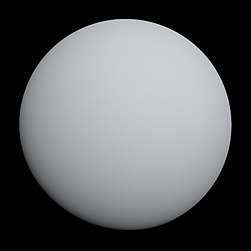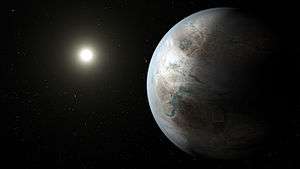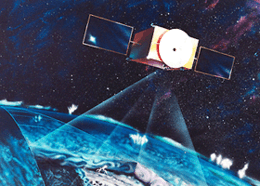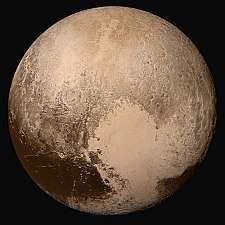K2-3c
| Exoplanet | List of exoplanets
| |||||
|---|---|---|---|---|---|---|
| Parent star | ||||||
| Star | K2-3 | |||||
| Constellation | Leo[1] | |||||
| Right ascension | (α) | 11h 29m 20.3918s[2] | ||||
| Declination | (δ) | −01° 27′ 17.280″[2] | ||||
| Apparent magnitude | (mV) | 12.168±0.009[3] | ||||
| Distance | 143.9±0.4[2] ly (44.1±0.1[2] pc) | |||||
| Mass | (m) | 0.612±0.086[4] M☉ | ||||
| Radius | (r) | 0.553±0.041[4] R☉ | ||||
| Temperature | (T) | 3835±70[5] K | ||||
| Metallicity | [Fe/H] | −0.01±0.09[5] | ||||
| Age | ≥1[6] Gyr | |||||
| Physical characteristics | ||||||
| Mass | (m) | 3.1+1.3 −1.2[5] M⊕ | ||||
| Radius | (r) | 1.77±0.18[5] R⊕ | ||||
| Density | (ρ) | 3.1+1.9 −1.3[5] g cm−3 | ||||
| Temperature | (T) | 374 K (101 °C; 214 °F) | ||||
| Orbital elements | ||||||
| Semi-major axis | (a) | 0.1413+0.0044 −0.0047[5] AU | ||||
| Eccentricity | (e) | 0.04±0.04[4] | ||||
| Orbital period | (P) | 24.64638±0.00017[5] d | ||||
| Inclination | (i) | 89.70±0.20[4]° | ||||
| Time of transit | (Tt) | 2456812.2777±0.0026[5] JD | ||||
| Semi-amplitude | (K) | 0.95±0.37[5] m/s | ||||
| Discovery information | ||||||
| Discovery date | 2015 | |||||
| Discoverer(s) | ||||||
| Discovery method | Transit | |||||
| Discovery site | Kepler Space Observatory | |||||
| Discovery status | Confirmed[6] | |||||
K2-3c also known as EPIC 201367065 c is an exoplanet orbiting K2-3 a red dwarf every 24 days. It is 144 ly away.[2] It has a density of 1.82g/cm3, indicating that it could be a Gas dwarf or a mini-Neptune. It is one of the smallest gas planets ever discovered. Despite not being the smallest planet in the system by radius,[7] by mass it is by far the least massive, with a mass only double that of Earth.[7]
References
- ↑ Roman, Nancy G. (1987). "Identification of a Constellation From a Position". Publications of the Astronomical Society of the Pacific. 99 (617): 695–699. Bibcode:1987PASP...99..695R. doi:10.1086/132034. Vizier query form
- 1 2 3 4 5 Brown, A. G. A.; et al. (Gaia collaboration) (August 2018). "Gaia Data Release 2: Summary of the contents and survey properties". Astronomy & Astrophysics. 616. A1. arXiv:1804.09365. Bibcode:2018A&A...616A...1G. doi:10.1051/0004-6361/201833051. Gaia DR2 record for this source at VizieR.
- ↑ Henden, A. A.; et al. (2016). "VizieR Online Data Catalog: AAVSO Photometric All Sky Survey (APASS) DR9 (Henden+, 2016)". VizieR On-line Data Catalog: II/336. Originally published in: 2015AAS...22533616H. 2336. Bibcode:2016yCat.2336....0H. Vizier catalog entry
- 1 2 3 4 "K2-3 c CONFIRMED PLANET OVERVIEW PAGE". NASA Exoplanet Archive. Retrieved 2015-10-17.
- 1 2 3 4 5 6 7 8 9 Damasso, M.; et al. (2018). "Eyes on K2-3: A system of three likely sub-Neptunes characterized with HARPS-N and HARPS". Astronomy and Astrophysics. 615. A69. arXiv:1802.08320. Bibcode:2018A&A...615A..69D. doi:10.1051/0004-6361/201732459.
- 1 2 Crossfield, Ian J. M.; et al. (2015). "A Nearby M Star with Three Transiting Super-Earths Discovered by K2". The Astrophysical Journal. 804 (1). 10. arXiv:1501.03798. Bibcode:2015ApJ...804...10C. doi:10.1088/0004-637X/804/1/10.
- 1 2 "K2-3 PLANET HOST PAGE". NASA Exoplanet Archive. Retrieved 2015-10-17.
This article is issued from
Wikipedia.
The text is licensed under Creative Commons - Attribution - Sharealike.
Additional terms may apply for the media files.




